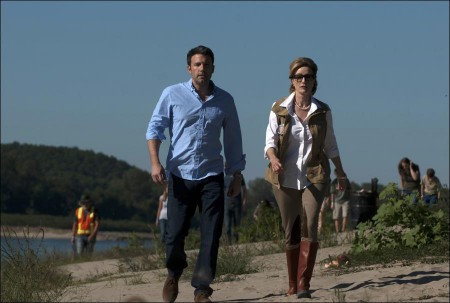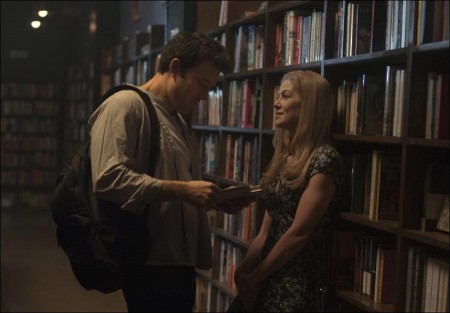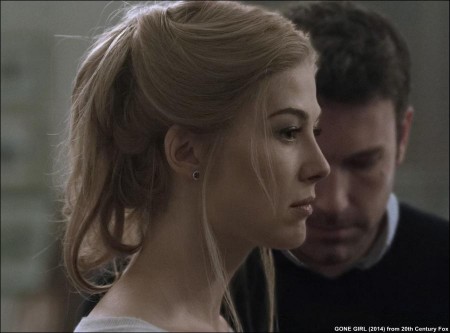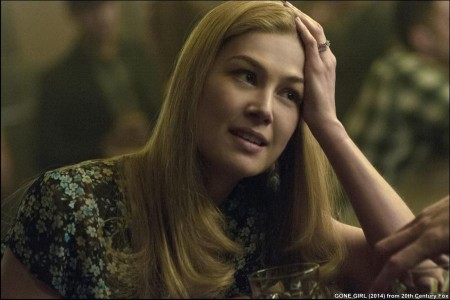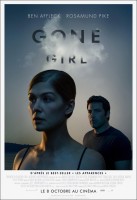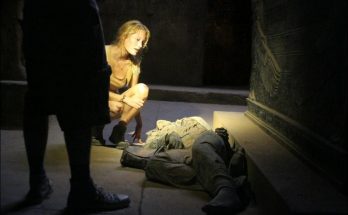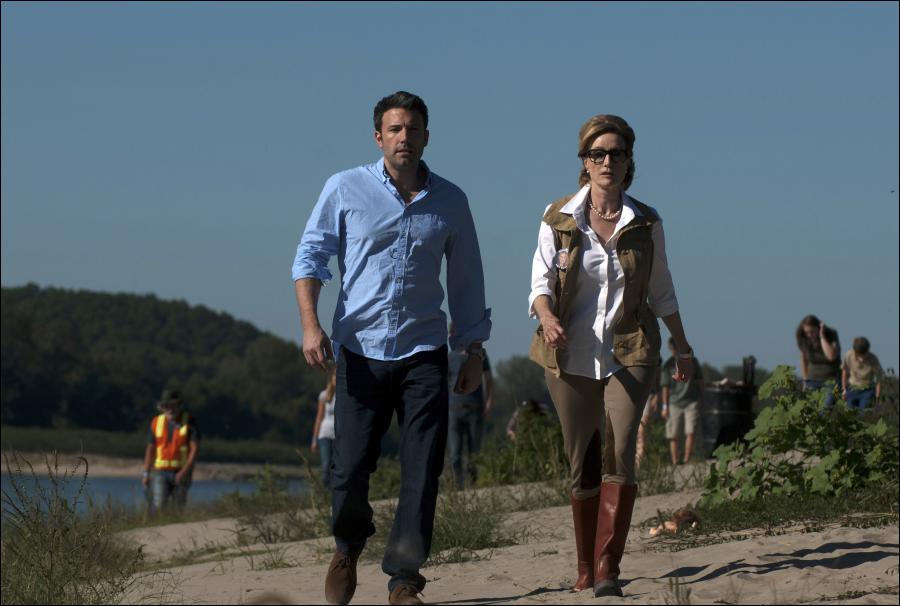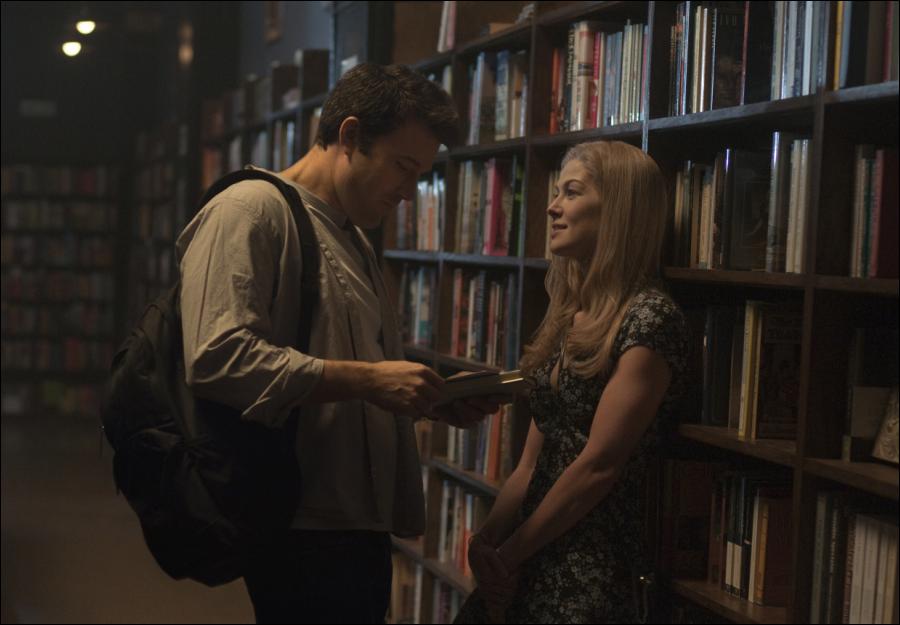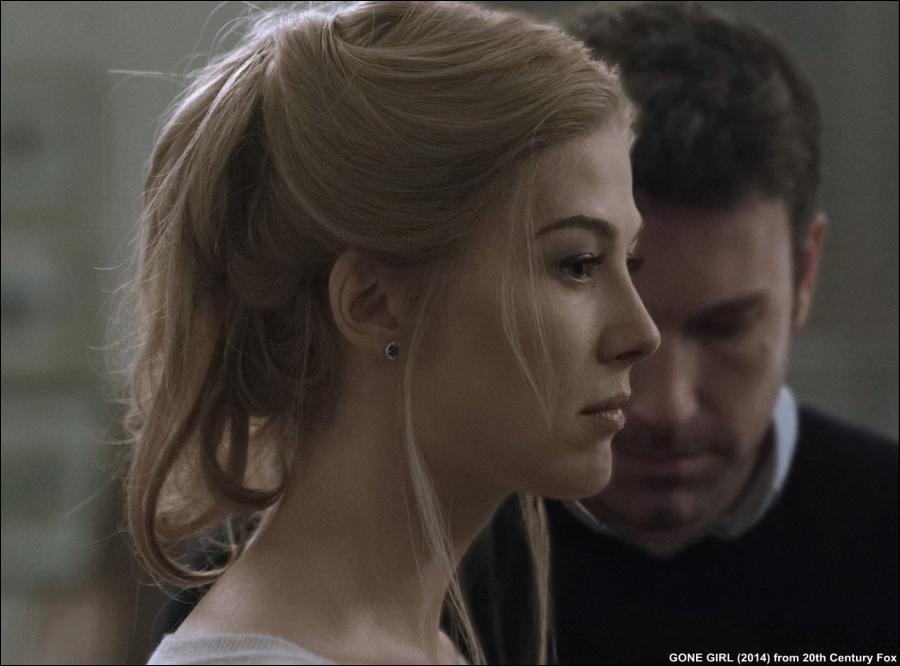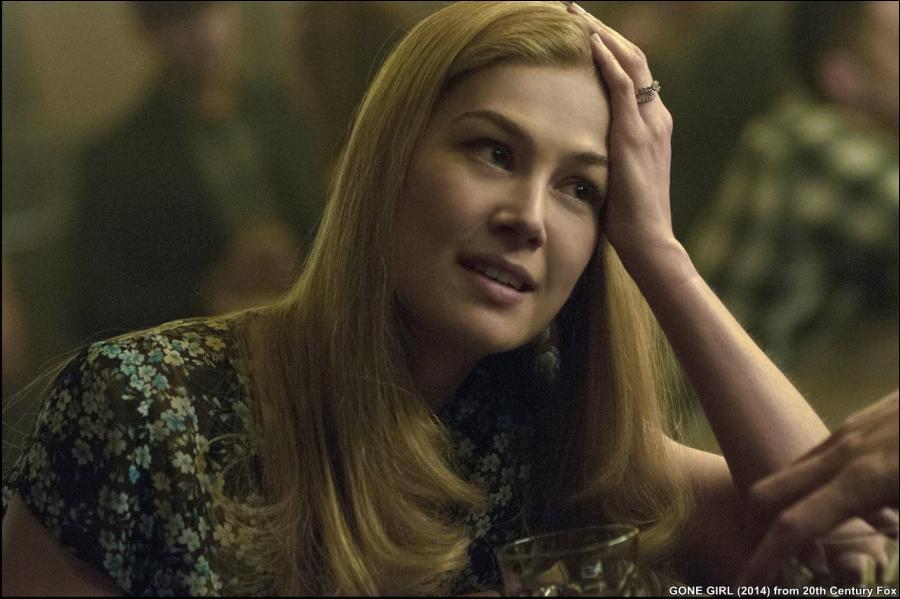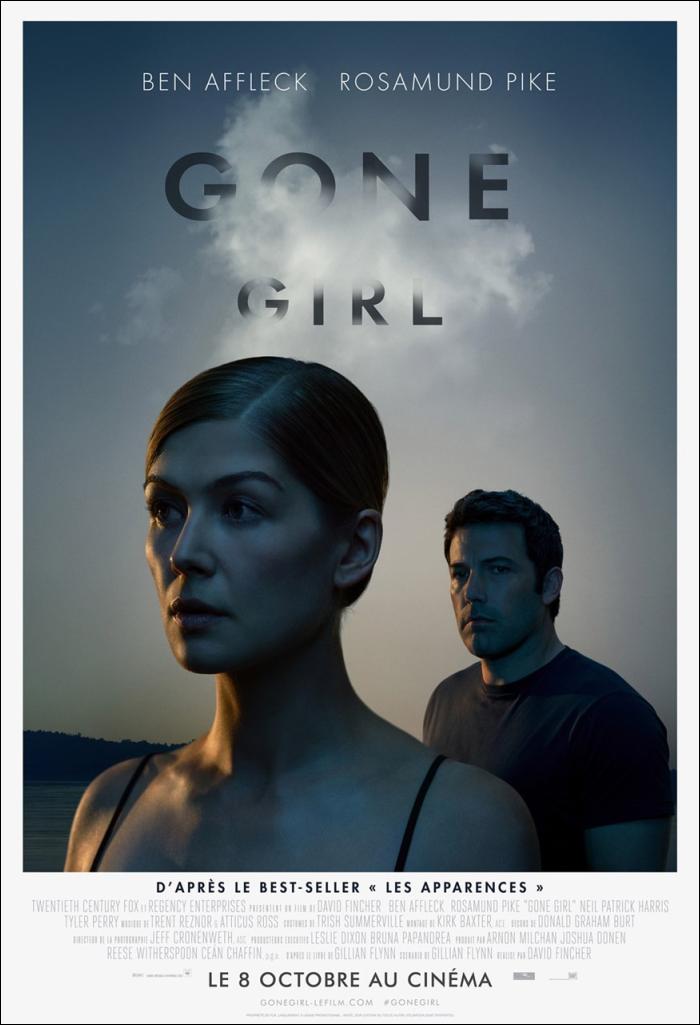Taglines: You don’t know what you’ve got ’til it’s…
Directed by David Fincher and based upon the global bestseller by Gillian Flynn, Gone Girl unearths the secrets at the heart of a modern marriage. On the occasion of his fifth wedding anniversary, Nick Dunne (Ben Affleck) reports that his beautiful wife, Amy (Rosamund Pike), has gone missing. Under pressure from the police and a growing media frenzy, Nick’s portrait of a blissful union begins to crumble. Soon his lies, deceits and strange behavior have everyone asking the same dark question: Did Nick Dunne kill his wife?
Gone Girl is an American mystery film directed by David Fincher and adapted by Gillian Flynn from her 2012 novel of the same name. It stars Ben Affleck, Rosamund Pike, Neil Patrick Harris, Tyler Perry, and Carrie Coon. The film had its world premiere on opening night of the 52nd New York Film Festival on September 26, 2014. It had its nationwide theatrical release on October 3 and received positive reviews from critics, who praised Fincher’s direction, Flynn’s script, score by Reznor and Ross, as well as the lead performances.
About the Production
“It’s a very difficult era in which to be a person, just a real, actual person, instead of a collection of personality traits selected from an endless Automat of characters. And if all of us are play-acting, there can be no such thing as a soul mate. ..” ― Gillian Flynn, Gone Girl
From the tour de force thriller that became a bestselling must read comes David Fincher’s screen version of Gone Girl, a wild ride through our modern media culture and down into the deep, dark fault lines of an American marriage – in all its unreliable promises, inescapable deceits and pitch-black comedy.
The couple at the center of the story – former New York writer Nick Dunne and his formerly “cool girl” wife Amy, now trying to make ends meet in the mid-recession Midwest – have all the sinuous outer contours of contemporary marital bliss. But on the occasion of their 5th wedding anniversary, Amy goes missing — and those contours crack into a maze of fissures. Nick becomes the prime suspect, shrouded in a fog of suspicious behavior. Amy becomes the vaunted object of a media frenzy as the search for her, dead or alive, plays out before the eyes of a world thirsting for revelations.
Just as Nick and Amy personified the quintessential romantic match, Amy’s disappearance has all the markings of an emblematic domestic American crime. But her vanishing becomes a kind of hall of mirrors in which tantalizing and savage secrets lead to tantalizing and savage secrets. The events that unfold are thick with shocks and complications, but the questions that remain are what cut, with razorsharp precision, to the bone: Who is Nick? Who is Amy? Who are any of us in marriages — and a society — built on a precarious base of projected images and disguises?
Adapting The Phenomenon to the Screen
Upon its 2012 publication, Gillian Flynn’s novel Gone Girl became that rare entity: a massively popular, nail-biting summer bestseller that was also the talk of the literary world. The book was lauded not only for relentless suspense, but also for its narrative ingenuity and willingness to plumb the murkiest depths of human behavior, grappling with the jagged lines between marriage and possession, public and private life, the lure of artifice and the glare of truth. Even in the crime fiction genre it stood out for its fusing of two stunningly unreliable, dueling narrators – the two halves of a torn marriage – who manipulate each other, tangling the reader in their webs of deceit.
The novel was a visceral, cinematic experience but filled with pitfalls for a screen adaptation. So strong were the voices in the book it seemed unlikely anyone could ever adapt it as well as its author. Fortunately, Flynn was up for taking on the daunting task and produced a screenplay that boiled the essence of her deftly plotted but deeply interior novel down into a skin-tight structure.
Then a synergy occurred between Flynn and David Fincher. The pairing of Flynn’s merciless insights with Fincher’s atmospheric storytelling made a potent mix with the drippingly dark humor of the story – and its skew on marriage, celebrity and the way we mold and remold our life stories.
“It was as if David interpreted what Gillian wrote and then that interpretation was put back through Gillian again on the page,” says Ben Affleck. “And during that process there was even more wit added, there was more sardonic stuff, and there were so many salient observations. It really fits into David’s work and has that distinctive combination of being at once funny and enlivening.”
Though she was already enmeshed in the fabric of the story, Flynn had her work cut out for her. “The novel has a rather complicated and intertwining plot—and it’s not easy to streamline because the pieces are so linked together—so my biggest concern was respecting the plot while making sure the film didn’t become all engine,” she explain of the adaptation. “I wanted to make sure to find room for the nuances, the relationships and the characters the dark humor and odd moments—because that’s where the creepy, toxic heart of the story lives.”
She’d always seen Fincher as a potential accomplice. “Even as I was writing the novel, there were certain scenes I pictured him filming—I could see them through his lens,” Flynn comments. “I knew he’d bring a great sense of place and I knew he’d capture the suspense and claustrophobia of the story. Everyone knows Fincher can do dread. But what I have always loved about his films is his dark bursts of humor. Gone Girl, for all its nastiness, has moments of humor, too, and I knew he’d bring those to the screen. I felt, too, that he wouldn’t turn Gone Girl into a rigid whodunnit, but would find room to explore what the story is really about, which is this marriage.”
“I loved working with Gillian,” says Fincher. “She is so hardworking, so diligent. She’s not one of these people that deflects or defends or obfuscates for any reason. She’ll slaughter her darlings. I have so much respect not only for her work ethic but also for the way she writes… as a popcorn eating, leaning-forward-in-the-2nd-row audience member. “
Fincher used the story’s nascent humor as a kind of dark marinade to soak into the visuals and performances. “People laugh in movies when they see something that is true,” says Fincher. “That’s what brings them out of their shells in the dark. If you then get the right people to carry the drama — and you encourage them to find what’s human about it all – that’s how you breathe life into it.”
For now though, Fincher believes the less said about the film’s plot perhaps the better. “I think this movie is best enjoyed walking in cold,” he says. “People love watching a movie where they don’t know where it’s going to go next. They go to the movies to be surprised.”
Facades And Interiors: The Gone Girl Landscape
The physical world of Gone Girl mirrors the internal states of its characters – or perhaps vice versa – with its portrait of a recession-era America full of comforting facades that, upon closer inspection, are fraying at the seams. The result is a kind of noir Americana, a darkly hypnotic angle on displaced American dreams. Fincher crafted this world of both strangeness and intimacy with a team he has relied on repeatedly including cinematographer Jeff Cronenworth, production designer Donald Graham Burt, costume designer Trish Summerville and editor Kirk Baxter.
Cronenworth has certainly gone down dark roads before with Fincher. Through a series of films including Fight Club, The Social Network and The Girl With The Dragon Tattoo the pair have forged a distinctive visual style that conjures potent atmospheres out of restraint. Driven by subtleties and details, their work on Gone Girl takes their aesthetic for the first time into the suburban Midwest. This film’s regionalism echoes the work of influential American street photographer Joel Sternfeld — who found both human beauty and ironic humor in modern, manmade landscapes.
The material itself helped to focus the approach. “Once I read Gillian’s script and started getting into David’s head and started to live vicariously through these characters and the mental chess games they play with each other and the emotional roller coaster they are on, the question became how can the visuals support this deep, dark journey?” explains Cronenworth. “We felt an obligation to visually immerse the audience in the fullest possible way into Gillian’s world.”
As for how camera and lighting become complicit in creating doubt and suspicion in a film where faux facades proliferate, Cronenworth says: “You look for ways to take a traditional, mundane small town and a couple’s impersonal home and subtly transform them into something mysterious.”
Filming took place in Cape Girardeau, a quaint Missouri River town a little over 100 miles outside St. Louis, which stands in for Nick’s downturned hometown of Carthage. Donald Burt notes that the location offered a lot of advantages. “Everything about Cape Girardeau was right – from its mix of different levels of economics and period architectures from the 60s, 70s and 80s to its sprawling malls to having the river right there as an anchor,” says the designer. “The people there were also so kind and so helpful. It shone a light on their remarkable generosity.”
Cronenworth was equally intrigued by the contours of Cape Girardeau in creating Carthage. “Carthage is much like many one-time prosperous towns across America where a highway came in and a few big box stores went up and suddenly the economic opportunities have moved down the road,” he describes. “I saw Carthage as a kind of a dusty old wedding gown that’s been kept in the closet. It still has a natural beauty and allure to it – but it hasn’t really been taken out and used for years.”
Practical locations were commandeered to hone in on this portrait. Burt explains, “With David it’s always about restraint but also finding things that are just a little bit off center. The idea is both ‘let’s keep it simple’ and yet ‘let’s keep it complex.’ We also make a concerted effort to constantly question ourselves; David often asks ‘do you think the characters would be in this place?’ And we explore things in that way, always through the characters.”
Adds Cronenworth: “I think David and Don and I all feel that the less we make obvious fingerprints, the more people are immersed in the atmosphere.”
Perhaps the most essential location was the Dunnes’ home, a rented McMansion in an affluent subdivision. Though shiny and new, shadows prevail within. “The Dunne’s house was all about taking a normal, ordinary domestic situation and turning it into an isolated fortress with the blinds drawn down,” Cronenworth explains. “From small details comes that sense of disenchantment.”
Burt and his team took a lot of care finding just the right house. “The house wasn’t too grand, yet it was large enough that two people could feel there was both closeness and at the same time a kind of separateness — the unspoken ‘don’t enter my space, I won’t enter yours.’ We wanted it to feel vacuous yet have layers,” the designer says. “It evoked the feeling of a McMansion without being disturbingly vulgar. We liked that it had classical elements, so that some of the wood in the Carthage house echoes their more historical townhome in New York but in a skewed way. It’s as if the house yearns to be traditional… but the hardware and the light fixtures and the vinyl windows give it away.”
The production lucked out in finding Desi’s lavish lakehouse nearby. “We found this spectacular home by a Frank Lloyd Wright student and it was just perfect. It felt remote but it spoke to money and yet it had a certain kind of prison quality,” Burt says.
One of the film’s literally darkest scenes takes place in an abandoned Missouri mall that has become a kind of mecca of the disenfranchised. Those sequences were shot in Los Angeles, using an abandoned Montgomery Ward store for the exteriors and the vast Hawthorne Mall for the interiors. “We dressed it with all this broken drywall and old dilapidated planters that you find in malls. We actually did a lot research on abandoned malls, because there are a lot across America,” says Burt. “There’s an apocalyptic feel – like there’s another, darker world underneath what you see in Carthage.”
For Cronenworth, it was a favorite location because of its challenges. “The scale was daunting in that you can see down 3 floors and 300 feet in each direction – and we wanted it all lit mostly with flashlights and bonfires,” he says. “It was one of the film’s most interesting photographic challenges. We wanted the scene to embrace that kind of catacombs feeling.”
Both men have found their work with Fincher deepening. Says Cronenworth: “I would say the main thing that has changed over the years is our ability to sleep a little more comfortably at night. We’re more decisive and efficient, which makes things just a little easier. But one thing that has stayed the same is that I go away every day on his films feeling like I’ve learned something.”
Burt has a similar take on their long-lived collaboration. “I’d like to think there’s a shorthand when you work with somebody enough – but I truly try to approach each project as a completely fresh experience, and this one was,” he says. “What strikes me most about David’s films is that there are so many elements that only hit you peripherally on first viewing, then later really sink in. It’s so often not the element that’s right in front of your face that is key and that is his unique artistry.”
The Sound of Gone
For the music that provides a surging undertow to Gone Girl, David Fincher returned again to work with Trent Reznor and Atticus Ross, who in addition to collaborating on Nine Inch Nails’ albums, together composed the scores for The Social Network and The Girl With The Dragon Tattoo. They have become valued partners in producing scores as atmospheric and assaultive as Fincher’s direction.
Reznor notes that the way they work with Fincher is something more instinctive and unstructured than conventional composition – and that these altered means lead to a different kind of result. “We’ve learned working with David over the last couple of films to deploy a strategy that, really by chance, became the right way to do things,” Reznor explains. “It all starts with spending as much time as we can trying to extract from David the role he envisions the music playing in the film.”
On Gone Girl that meant starting with the film’s time and place amidst economic and social transitions. “We talked about the promise of the Midwest and what’s happened to that part of the American Dream, with all these foreclosed mega-mansions and downtowns that are being abandoned. We talked about the idea that this is a story about people presenting themselves to the world as they wish they could really be, at the same time that things around them are curdling,” Reznor says. “From that came the discussion of what palette of sounds, what instrumentation, what colors on the easel could create that. We wanted the sound to be distressed – where everything feels a little beaten up.”
A typically, Reznor and Ross compose conceptually long before they ever see reels of the film, continuously honing the score as the final film comes together. It’s a time-consuming, creatively daunting process, but one that can lead down unexpected alleys. “We work almost subconsciously based often just on textures and swatches,” Reznor delineates. “After a few weeks of working this way, we’ll turn in some music to see if what we are doing is resonating with what is in David’s head. It probably takes about 30 times as long to work in this way but it’s what feels right.”
The kick-off point for the music was the kind of softly benign strains you might hear whilst on a spa massage table. “We thought, what if we start with something almost grotesquely sweet and then reveal what’s under that surface,” Reznor says. “We incorporated spa-like moments, but then explored how to make them turn unpleasant, to peel off the layers so you feel the unraveling.”
Reznor continues: “In terms of the palette of sounds what’s unique on this one is that we used a more organic, less synthetic soundscape. We didn’t want it to feel too slick so we used a lot of interesting homemade equipment. There are moments where the rhythm is just me tapping on a wooden box so it feels repetitive but drifts around a bit like a human heartbeat.”
As for why he and Ross keep coming back to work with Fincher, Reznor says: “We’ve had such magical, inspirational and artistically rewarding experiences with him that it spoils you,” he says. “You realize how rare it is for really great films to pop up.”
Ultimately, over time, the music became a uniting thread weaving through all the other elements. “There was a moment when we turned in a batch of material and we got that sense of excitement from David and Kirk that we’d zeroed in on something that helped inspire them to tie the whole movie together. It’s like that moment when you’re recording and it coalesces into a true album and no longer just a collection of songs.”
Gone Girl
Directed by: David Fincher
Starring: Ben Affleck, Rosamund Pike, Neil Patrick Harris, Carrie Coon, Kim Dickens, Lisa Banes, Missi Pyle, Casey Wilson, Sela Ward
Screenplay by: Gillian Flynn
Production Design by: Donald Graham Burt
Cinematography by: Jeff Cronenweth
Film Editing by: Kirk Baxter
Costume Design by: Trish Summerville
Set Decoration by: Douglas A. Mowat, Gena Vazquez
Music by: Trent Reznor, Atticus Ross
MPAA Rating: R for a scene of bloody violence, some strong sexual content / nudity, and language.
Studio: 20th Century Fox
Release Date: October 3, 2014
Visits: 86
